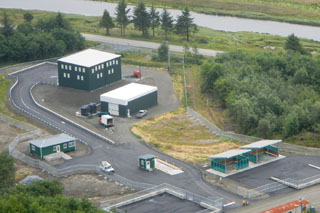|
Subscribe / Renew |
|
|
Contact Us |
|
| ► Subscribe to our Free Weekly Newsletter | |
| home | Welcome, sign in or click here to subscribe. | login |
Environment
| |
 |
February 28, 2013
New transfer station lifts Makahs out of the dumps
Ridolfi

Ridolfi
|
After decades of living with the old and harmful technology of an open dump, the Makah tribe recently launched a new, state-of-the-art waste transfer station. The Makah Tribal Council spearheaded design and construction of the facility, with emphasis on culturally meaningful green practices and sustainability in everything from site selection to waste diversion.
The Makah reservation, a small community of less than 2,000 people, is situated in a remote area of the Olympic Peninsula at Neah Bay. Beginning in the early 1970s, an open dump at Warmhouse Beach was used by the U.S. Air Force to dispose of both solid waste and hazardous waste. For the last 20 years or more, the Warmhouse Beach Open Dump has been the tribe’s only option for disposing of solid waste on the reservation.
Traditionally, the Makah tribe used Warmhouse Beach, which overlooks the Strait of Juan de Fuca and the Pacific Ocean, as a summer fishing camp. Today, the dump poses a serious environmental threat to the people and natural resources of the Makah reservation.
Groundwater and surface water are contaminated with arsenic, lead, hydrocarbons such as used oil, and other hazardous substances. Because of this, closing and cleaning up the Warmhouse Beach Open Dump have long been top priorities for the tribe. But closure of the dump hinged on developing a new waste transfer station to replace it.
The Makah Tribal Council was determined to achieve these long-term goals. For over a decade, the tribe pursued waste characterization of the open dump, design alternatives for the new waste-handling facility, and funding sources for the many studies necessary to accomplish these tasks.
A struggle for funding
According to Steve Pendleton, environmental program manager for the Makah tribe, getting the transfer station up and operating has been a long struggle for the tribe.
“In Indian country, there is a patchwork of grants and tribal money,” says Pendleton, making funding complicated and time-consuming.
Financial assistance for the planning phase came from the U.S. Environmental Protection Agency and the Indian Health Service. Then the tribe secured funding from U.S. Department of Agriculture Rural Development to complete the design, prepare construction drawings and specifications, and construct the facility.
Because of the tribe’s resolve and persistence, the Makah Transfer Station opened last October.
The complex includes an administration building; a recycling center; a compacting area for solid waste, which is ultimately shipped off the reservation for disposal; a weigh station; a maintenance shop; and an exchange area where community members can drop off and pick up reusable items, keeping them out of the waste stream.
Transfer station features
The tribe’s commitment to green practices and sustainability to benefit the environment and the community is evident in every aspect of the new facility, from construction to operation:
• Low-impact site selection: The tribe chose a site that had been previously disturbed by equipment storage and maintenance facilities as opposed to undeveloped land.
• Protection of wetlands: The transfer station is surrounded by wetlands. Careful site planning and sensitivity to the important services wetlands provide meant that no wetlands were lost or adversely impacted.
• Reuse of existing structures: The tribe asked the design team to keep and reuse an old shop building already on the site. Architectural and structural evaluations demonstrated that portions of the building could indeed be renovated and reused. The new shop building incorporates the concrete block walls and floor and part of the roof of the old structure.
• Rainwater harvesting: Rainfall at Neah Bay averages 100 inches annually, while the storage capacity for drinking water is low. A rainwater harvesting system installed at the facility conserves the scarce drinking water resource by collecting and storing rainwater for uses like washing equipment.
• Natural stormwater controls: Stormwater and associated sediment are controlled by filtering and storing stormwater in natural vegetated swales, channels and ponds before allowing it to seep into the adjacent wetlands. Use of impermeable surfaces is limited, encouraging stormwater infiltration.
• Diversion of household hazardous waste: Community members now have a separate station where wastes such as paints, solvents and used oil are safely collected for proper disposal.
• Diversion of reusable materials: Clothing, toys, tools and other household goods that are still usable are collected at the transfer station and made available for free redistribution to other community members, benefiting pocketbooks as well as the environment.
• Diversion of recyclable materials: Paper, cardboard, plastic, metal cans and other recyclables are collected for sale to recycling markets.
• Diversion of major appliances and junked vehicles: Because the reservation’s remote location made disposal of these materials difficult, they used to be abandoned on the reservation. Bulky metal debris is now collected at the transfer station for recycling and disposal.
• Proper and efficient waste disposal: Although reduced in volume, some discarded material must still be disposed of. The solid waste is compacted for efficient transport and shipped to a permitted regional landfill.
• Energy conservation: The electrical and lighting systems take advantage of energy-efficient equipment. Natural light enters the transfer station building through translucent panels, and lighting controls keep the lights off when they’re not needed.
Closing the open dump
Completion of the Makah Transfer Station is the culmination of a challenging and complex process to design and fund the facility. It is also an important milestone on the critical path to closing the Warmhouse Beach Open Dump, which poses a serious environmental threat to the people and natural resources of the Makah tribe.
The Makah Transfer Station provides services that less-remote communities might take for granted, but its significance goes far beyond simple trash collection and recycling. Because of the tribe’s commitment to green practices and sustainable construction and operation, the Makah Transfer Station is also a bridge between the modern experience and the tribe’s ethic of respect for the natural environment of land and sea.
Bruno Ridolfi is principal engineer for Seattle-based Ridolfi, where he specializes in waste management, environmental restoration, energy conservation and strategic planning for projects conducted in the natural environment.
Other Stories:
- Don’t let green-minded clients leave you behind
- Engineering school’s new home reflects its values
- Falling costs could mean a bright future for solar panels
- Is LEED’s future with federal projects under threat?
- A crucial step that green building teams often skip
- Thermal ‘ravioli’ keeps building temps in check
- Bullitt neighbor seeks a green distinction of its own
- How contractors can make the supply chain greener
- What to look for in a green building



